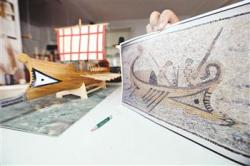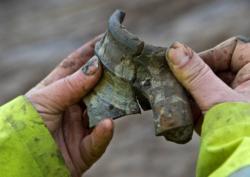INSTITUT SUPERIEUR D'ANTHROPOLOGIE
INSTITUTE OF ANTHROPOLOGY
ONLINE COURSES / COURS A DISTANCE
FALL TERM : OCTOBER 2013
REGISTER NOW
TURQUIE –  Phaselis - A ship that served both for trade and as a warship in the ancient city of Phaselis in the southern province of Antalya will be reconstructed by Akdeniz University’s Mediterranean Research Institute. The 600-person capacity ship, named “Phaselos,” will make its first trip to Egypt. The ancient city of Phaselis, located in Tekirova, had its heyday between the seventh century B.C. and second century A.D. It was one of the significant ports of Lycia and Pamphylia, and used to carry different products to Egypt and the Black Sea countries. The ship also sailed during wartime. The director of the institute, Murat Arslan, said they would start the second surface survey for the ship reconstruction Aug. 20. He said the plans for Phaselos had been drawn based on ancient mosaics, and Ümit Durak, who has been making ship models since 1993, had made a model of the ship. He said they would make a replica of Phaselos in the second leg of the project with the support of Professor Hayat Erkanal from 360 Degree Research Group and archaeologist Osman Erkurt. “We will build the ship and go to Egypt and Alexandria just like in the ancient ages. The project is set to be completed in five years,” he concluded.
Phaselis - A ship that served both for trade and as a warship in the ancient city of Phaselis in the southern province of Antalya will be reconstructed by Akdeniz University’s Mediterranean Research Institute. The 600-person capacity ship, named “Phaselos,” will make its first trip to Egypt. The ancient city of Phaselis, located in Tekirova, had its heyday between the seventh century B.C. and second century A.D. It was one of the significant ports of Lycia and Pamphylia, and used to carry different products to Egypt and the Black Sea countries. The ship also sailed during wartime. The director of the institute, Murat Arslan, said they would start the second surface survey for the ship reconstruction Aug. 20. He said the plans for Phaselos had been drawn based on ancient mosaics, and Ümit Durak, who has been making ship models since 1993, had made a model of the ship. He said they would make a replica of Phaselos in the second leg of the project with the support of Professor Hayat Erkanal from 360 Degree Research Group and archaeologist Osman Erkurt. “We will build the ship and go to Egypt and Alexandria just like in the ancient ages. The project is set to be completed in five years,” he concluded.
http://www.hurriyetdailynews.com/ancient-ship-to-set-sail-again-to-egypt.aspx?pageID=238&nID=52276&NewsCatID=375
IRLANDE -  Limerick - Council workers have discovered 700 year old human skulls and bones as they dug up a new site. At least three human skulls, and an assortment of human and animal bones were discovered close to the surface when workers dug up the site on Nicholas Street in Limerick city. The area is the historic old quarter of the city where the Vikings landed in the 10th Century. Brian Boru, High King of Ireland during the 11th Century, is also reputed to have resided in a castle adjacent to where the skeletal remains were found. St Mary’s Protestant Church now lies on the old castle grounds at Merchants Quay. Linda Lynch, a freelance Osteo Archaeologist, who specialises in examining human bones, was drafted in to help determine the age of the remains. “There is a medieval church on maps in the area dating back to the 13th Century and its thought there was a graveyard attached. We’ll have to radio carbon test the bones to try and get an age on them,” Ms Lynch explained. “The human bones were discovered in a disarticulated state and there were a lot of butchered animal bones too. We found leg bones, arm bones, which have been disturbed through the years.” “I’m brought in when human remains are found. We’ll have to check if the bones are forensic or archaeological. We’re going to report on what we’ve found,” Ms Lynch added. The bones were discovered adjacent to the front doors of the former Widow Alms Houses built for impoverished widows in 1691.
Limerick - Council workers have discovered 700 year old human skulls and bones as they dug up a new site. At least three human skulls, and an assortment of human and animal bones were discovered close to the surface when workers dug up the site on Nicholas Street in Limerick city. The area is the historic old quarter of the city where the Vikings landed in the 10th Century. Brian Boru, High King of Ireland during the 11th Century, is also reputed to have resided in a castle adjacent to where the skeletal remains were found. St Mary’s Protestant Church now lies on the old castle grounds at Merchants Quay. Linda Lynch, a freelance Osteo Archaeologist, who specialises in examining human bones, was drafted in to help determine the age of the remains. “There is a medieval church on maps in the area dating back to the 13th Century and its thought there was a graveyard attached. We’ll have to radio carbon test the bones to try and get an age on them,” Ms Lynch explained. “The human bones were discovered in a disarticulated state and there were a lot of butchered animal bones too. We found leg bones, arm bones, which have been disturbed through the years.” “I’m brought in when human remains are found. We’ll have to check if the bones are forensic or archaeological. We’re going to report on what we’ve found,” Ms Lynch added. The bones were discovered adjacent to the front doors of the former Widow Alms Houses built for impoverished widows in 1691.
http://www.irishmirror.ie/news/irish-news/skeleton-found-in-limerick-city-2146038
ROYAUME UNI-  Wisbech - The findings were made by a team of archaeologists at a site being developed by Wisbech-based contractor Foster Property Maintenance (FPM) for housing. Excavators Oxford Archaeology East discovered a round Roman structure and some medieval pits, postholes and ditches, all of which will be preserved. An archaeological evaluation identified an undated ring-shaped feature about 10m in diameter, thought to be a Roman round house, where a family would have lived. Small amounts of Roman pottery and medieval ditches, pits and pottery were also found. These findings led Daniel McConnell, senior archaeologist at Cambridgeshire County Council, to undertake a further excavation. This found a probable 12th or 13th century fen circle, which is a corn or hay stack, within the centre of the excavation area, with a small gully around it for drainage. The site was abandoned in about the 14th century and it is thought the area reverted to pastoral farming until recent times. Several hundred pieces of pottery, animal bone and other artefacts are undergoing analysis, which will form the basis of a publication.
Wisbech - The findings were made by a team of archaeologists at a site being developed by Wisbech-based contractor Foster Property Maintenance (FPM) for housing. Excavators Oxford Archaeology East discovered a round Roman structure and some medieval pits, postholes and ditches, all of which will be preserved. An archaeological evaluation identified an undated ring-shaped feature about 10m in diameter, thought to be a Roman round house, where a family would have lived. Small amounts of Roman pottery and medieval ditches, pits and pottery were also found. These findings led Daniel McConnell, senior archaeologist at Cambridgeshire County Council, to undertake a further excavation. This found a probable 12th or 13th century fen circle, which is a corn or hay stack, within the centre of the excavation area, with a small gully around it for drainage. The site was abandoned in about the 14th century and it is thought the area reverted to pastoral farming until recent times. Several hundred pieces of pottery, animal bone and other artefacts are undergoing analysis, which will form the basis of a publication.
http://www.wisbechstandard.co.uk/news/fascinating_roman_and_medieval_relics_discovered_at_site_of_future_housing_development_in_parson_drove_1_2328529
ROYAUME UNI - Low Hauxley - An ancient peat bed, Neolithic remains, Roman pottery and a Bronze Age burial cairn – these are just some of the exciting discoveries made as part of a major archaeological dig. And the project has also revealed that a devastating tsunami most probably took place thousands of years ago, burying much of the Low Hauxley coastline. Cliff erosion over the last few years has gradually exposed part of the Bronze Age cairn, believed to date back to about 2200BC. Archaeologists believe a tsunami completely covered the area at Low Hauxley around 4,000 years ago, after which the place was abandoned. The cairn is now exposed and excavations have continued to expose layers beneath it.
http://www.northumberlandgazette.co.uk/news/local-news/major-dig-helps-to-reveal-the-secrets-of-past-1-5932507